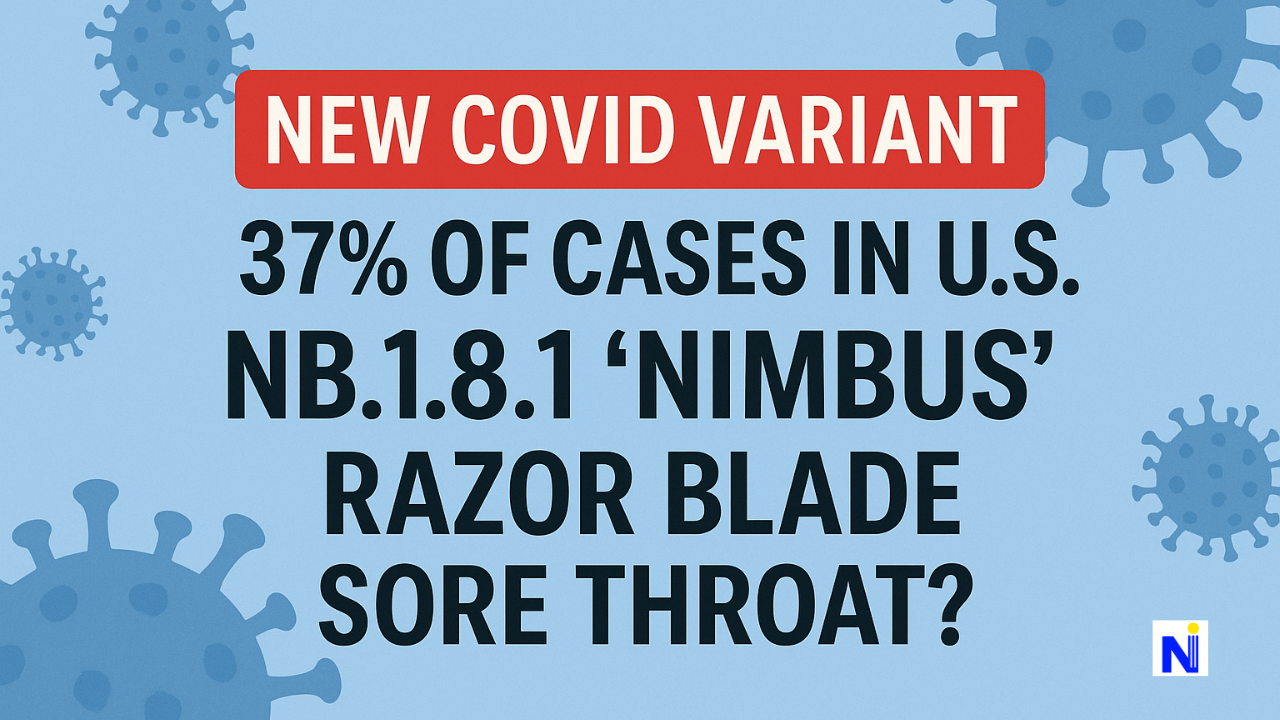
It starts with a little tickle. Then your throat feels like you swallowed sandpaper wrapped in barbed wire. Sound familiar? You might be experiencing what people are now calling a “razor blade sore throat”—a telltale sign of NB.1.8.1, or “Nimbus,” the latest COVID-19 variant quietly dominating the U.S.
With summer travel heating up and social calendars filling fast, this new strain is spreading quickly—now responsible for nearly 37% of all new cases. So, what exactly is this “Nimbus” variant? Should you be worried? And is that annoying sore throat something more?
Let’s break it all down—symptoms, spread, vaccines, and the truth behind the new variant making headlines.
🌎 What Is the NB.1.8.1 ‘Nimbus’ Variant?
🧬 Origin and Spread
- First detected in the U.S. in late March 2025.
- Nicknamed “Nimbus” by evolutionary biologist T. Ryan Gregory.
- Offshoot of the recombinant Omicron subvariant XDV.1.5.1.
- Has spike protein mutations that may help it spread and evade antibodies.
By early June, the variant had spread to at least 14 U.S. states, with sequencing data showing detections in:
States Reporting NB.1.8.1 (as of June 13):
| West | Midwest | Northeast | South |
|---|---|---|---|
| California | Illinois | New York | Virginia |
| Arizona | Ohio | New Jersey | Maryland |
| Colorado | Rhode Island | ||
| Washington | Massachusetts | ||
| Hawaii | Vermont |
Worldwide, it’s been reported in 22+ countries, now making up roughly 10.7% of global cases.
📈 Is Nimbus More Transmissible?
While official studies are ongoing, early data suggest:
- Higher transmissibility: Mutations allow stronger binding to human cells.
- Immune escape potential: May dodge immunity from past infection or vaccination.
- Not more severe (yet): No evidence suggests it causes worse illness than previous strains.
“It’s likely that NB.1.8.1 is more contagious than others, but thankfully, it doesn’t appear more dangerous,” — Dr. Angela Lee, Infectious Disease Specialist, Boston General.
🧊 COVID Is Cooling, But For How Long?
Despite Nimbus’s rise, as of early June:
- Test positivity: ~3% (only up 0.2% from previous week).
- Hospitalizations: Decreasing.
- Wastewater viral load: Low.
But experts warn that summer spikes are nothing new. Each year since 2020, COVID cases have surged between June and August—often due to new variants, vacations, and crowded events.
😷 Symptoms of the NB.1.8.1 ‘Nimbus’ Variant
Many Nimbus infections feel similar to a bad cold or mild flu—but the sore throat? Brutal.
Most Common Symptoms:
- “Razor blade” sore throat
- Runny nose or congestion
- Dry or wet cough
- Fever or chills
- Headache
- Fatigue
- Body aches
- Shortness of breath
- Loss of smell or taste
“It was like swallowing glass. I tested positive the next day,” says Jessie Morgan, 34, from Denver, who recently caught Nimbus after attending a wedding.
While symptoms usually remain mild, older adults (65+), immunocompromised individuals, and those with chronic conditions remain most vulnerable to severe outcomes.
💉 COVID Vaccines and the New Variant
Wondering if you should get another shot?
Here’s the current situation:
- 2024–2025 vaccines: Still available, recommended for anyone 18+ who hasn’t had a shot in the past 6 months.
- 2025–2026 updated shots: Coming this fall, targeting LP.8.1 (current dominant variant).
- Access changes:
- Limited to:
- Adults 65+
- Ages 12–64 with underlying conditions
- Not recommended for healthy kids or pregnant women per latest CDC guidance (though some doctors disagree).
- Limited to:
“Those at higher risk should consider vaccinating now and again before winter,” advises Dr. Albert Ko, Yale School of Public Health.
🛡️ Existing vaccines still offer protection against severe disease—even from Nimbus.
📉 Could This Spark Another Summer Wave?
Possibly. But not a 2020-style meltdown.
Why Experts Are Cautiously Optimistic:
- High population immunity: 90%+ of Americans have prior exposure via infection or vaccination.
- Lower severity overall: Hospitalizations and deaths remain manageable.
- But… immunity fades, especially with newer mutations.
Dr. Andy Pekosz of Johns Hopkins warns:
“The further we get from the last vaccine or infection, the more people become vulnerable again.”
Add summer travel, barbecues, and crowds, and you’ve got a recipe for rising numbers.
🔍 What Can You Do to Stay Safe?
No need to panic—but stay proactive.
Practical Tips:
- Test when symptoms appear (at-home kits still available at pharmacies).
- Isolate if you test positive.
- Mask indoors in crowded places.
- Get vaccinated if eligible.
- Wash hands regularly.
- Ventilate indoor spaces.
📦 The government no longer sends free test kits, but low-cost or insurance-covered ones are easy to find.
🤔 FAQs About NB.1.8.1 Nimbus
1. Is NB.1.8.1 more dangerous than other variants?
No, current data suggests it’s not more severe than other recent Omicron strains.
2. What is the “razor blade sore throat”?
It refers to the intense throat pain reported by many infected with the Nimbus variant.
3. Will vaccines still work against Nimbus?
Yes, current vaccines remain effective at preventing severe disease and hospitalization.
4. Can I still get a COVID test or vaccine for free?
Some low-cost test options are available, and vaccines are free for high-risk groups. Check your insurance or local health department.
What We Know and What’s Next
The “Nimbus” variant is fast, but not ferocious at least for now. With summer coming, staying informed is your best weapon. Keep that hand sanitizer close, stock up on tissues, and don’t ignore that sore throat—it could be more than just allergies.
✅ Share this with your friends who still think “COVID’s over.”
💬 Got a question or personal experience with NB.1.8.1? Drop it in the comments!






